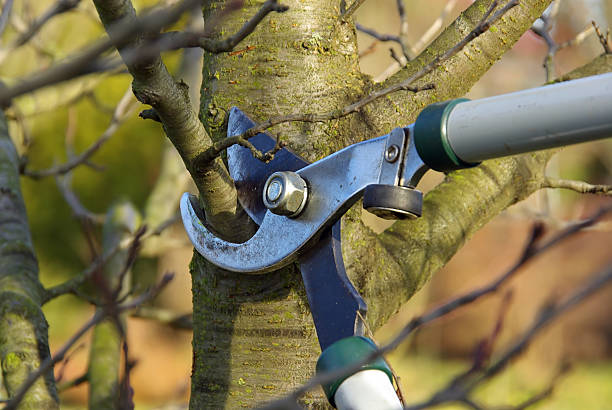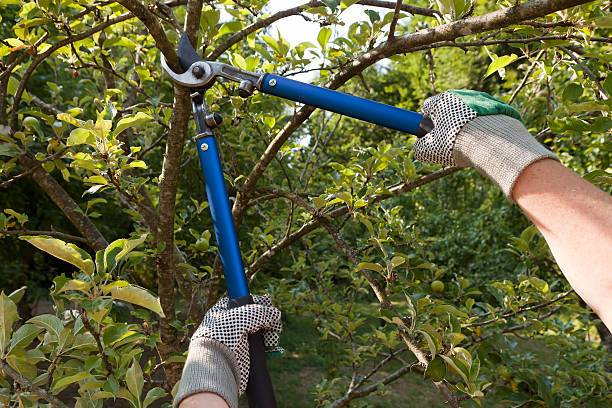Many people prune their trees after a storm or to correct damage caused by wind or insects. Other reasons include encouraging flowers and fruit production, reducing safety hazards, or improving overall tree shape.
When removing branches, perform a reduction cut by shortening the terminal back to a lateral that is at least a third of the diameter of the one you are removing. This is a good practice that promotes sound wound closure.

Dormant Pruning
Dormant Pruning is a pruning technique performed in late fall and winter to reduce the risk of damage from heavy snow and ice. It involves removing dead branches and reshaping overgrown trees. It also improves the appearance of the property and encourages new spring growth.
When done correctly, this technique can also reduce the number of limbs that break off during harsh winter weather. In addition, it removes limbs that block vital areas of the property like views and prevent sunlight from reaching turf and understory plantings.
This pruning technique can also be used to remove suckers and water sprouts that compete with the desired central leader of the tree. Cutting these off when they are dormant will eliminate the need to prune them again in the future.
Another benefit of dormant pruning is that cuts made during this time heal much faster than in the summer when the plant is growing. This is because the fungi and bacteria that cause disease are dormant during this time. In addition, pruning in the winter limits the amount of sap lost as a result of cuts which can otherwise be stressful for the tree. It’s also easier to see the structure of a tree during dormant pruning, which allows for more precise and accurate cuts. This is particularly true for large shade trees with multiple limbs.
Summer Pruning
The summer season can be a busy time for trees, as they produce ripe fruit and work to keep leaves in order. It is important to continue structural pruning during this season, removing broken, diseased or rubbing branches and thinning the crown of the tree as necessary. Uppercut Tree Services is using methods like crown raising or modified central leader training to promote fruit production in apple, pear, plum, and apricot trees, while also maintaining tree structure and safety.
A key part of summer pruning is the removal of suckers and watersprouts. These are twiggy vertical growths that are often found at the base of larger limbs and can take away energy from the developing fruits of your trees.
The best time to remove suckers and watersprouts is in early spring before they grow too large. This can be done with a sharp shears or hand pruners. It is also the ideal time to thin a canopy, reducing its size and letting more light reach lower branches. Having fewer leaves to deal with makes pruning during the summer much faster and more efficient, and helps arborists get a better understanding of how a tree will handle stormy weather conditions come fall and winter.

Autumn Pruning
Many evergreen trees and shrubs with needlelike or scalelike foliage (such as spruce, juniper, arborvitae, cypress, and yew) can be pruned during autumn. This pruning technique encourages new root growth at the cutting site and helps these species establish in their landscapes.
Structural pruning is best performed when the tree is young and pliable, but it can be done at any developmental age. Performing structural corrections at a young stage can reduce risk, prevent failure as the tree matures and is far easier and less costly than correcting faults in mature trees.
Crown thinning is another tree pruning Rye practice that can be beneficial to most types of trees. This pruning technique removes specific live branches to reduce the overall density of a tree, often resulting in increased sunlight penetration and air circulation throughout the crown. It can also reduce stress on selected limbs from gravity, wind, snow, and ice, especially on the outermost portions of the crown.
It is important to remember that all cuts on a tree should be made just outside the branch bark ridge, avoiding leaving stubs. In addition, it is a good idea to avoid using paint or wound dressings on pruning cuts, as these materials can interfere with the natural healing process and lead to rot and insect infestations. If you’re not experienced with tree pruning, it’s recommended to get a tree pruning services.
Winter Pruning
The winter season is the perfect time to prune trees because they go dormant. This is the signal for them to prepare their soft tissues for freezing temperatures and dry weather. Pruning during other seasons is stressful on the tree and can stimulate additional growth that won’t be able to harden before cold weather arrives.
Dormant pruning is also less stressful for the arborist because all of the leaves have fallen. This allows them to really evaluate a tree’s structure and determine its needs. Additionally, pruning during the winter allows for a safer work environment. Pruning branches that hang over power lines or other structures requires special training and safety equipment.
During this time of year, the focus should be on removing dead or damaged branches, and thinning out the crown. It is also a good opportunity to remove suckers and vigorous vertical shoots that pull on the main stem or trunk, such as water sprouts. When cutting large limbs, start the cut on the underside of the branch to avoid tearing bark. Always make the final pruning cut just outside of the branch collar and branch bark ridge. This prevents the formation of a callus that is detrimental to wound closure.
Never “flush” a cut (cutting the stem to just above an existing bud or node) because this creates wounds that are more likely to die back, resulting in decay and insect infestation. A flush cut is also more susceptible to ice damage and can lead to a weakened structure, which makes the tree vulnerable to damage or breakage during stormy weather.